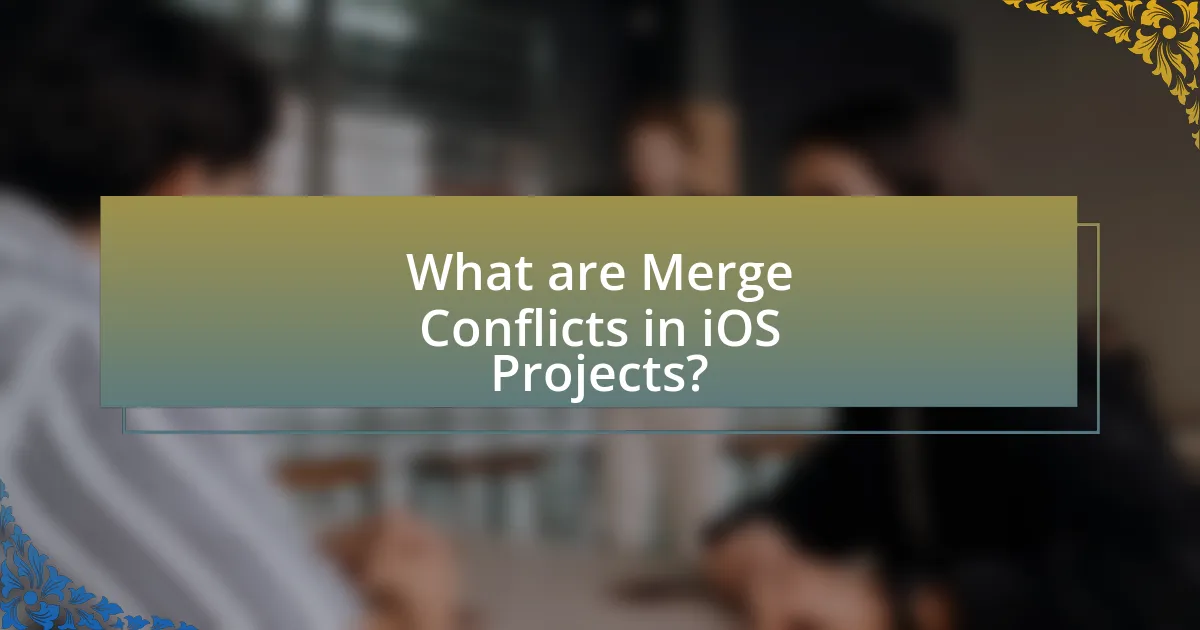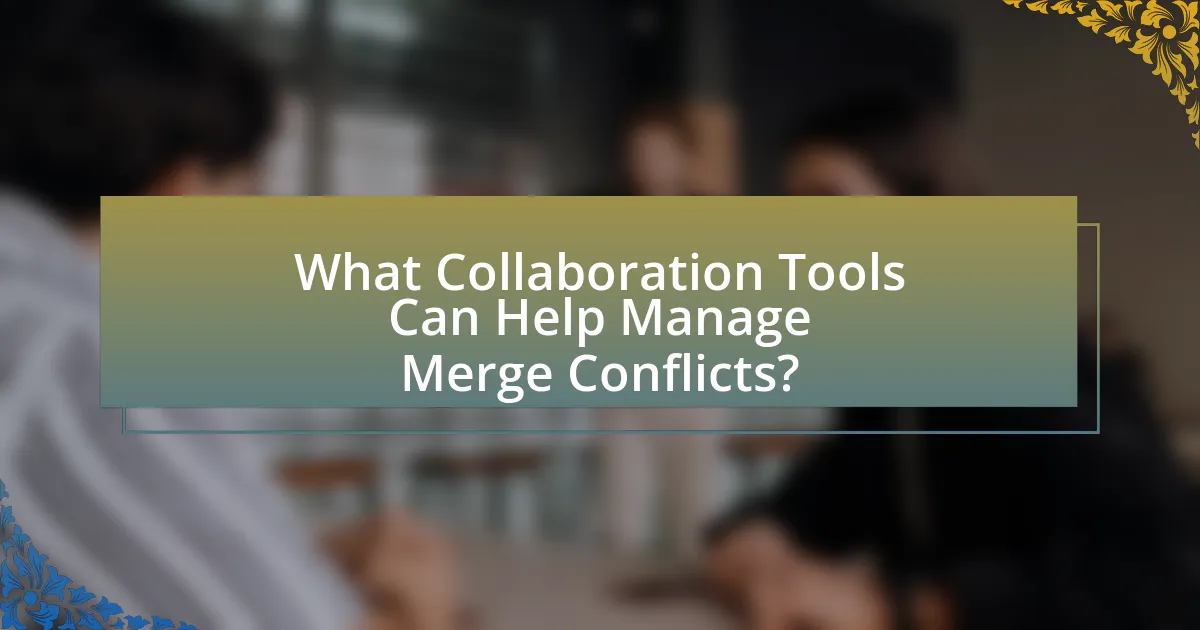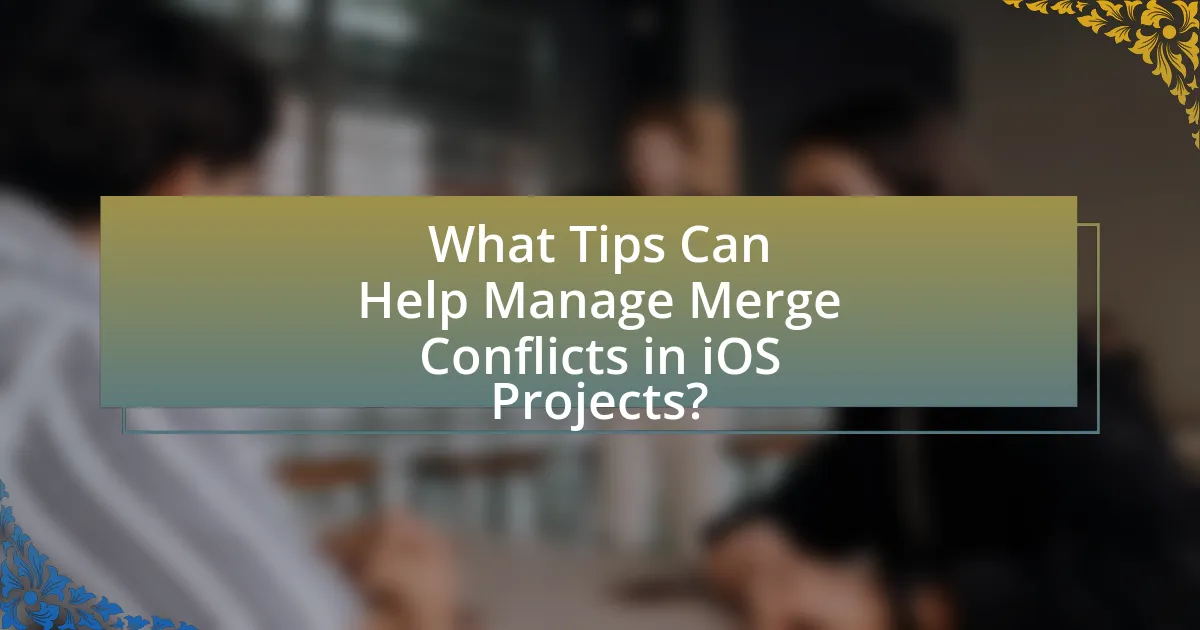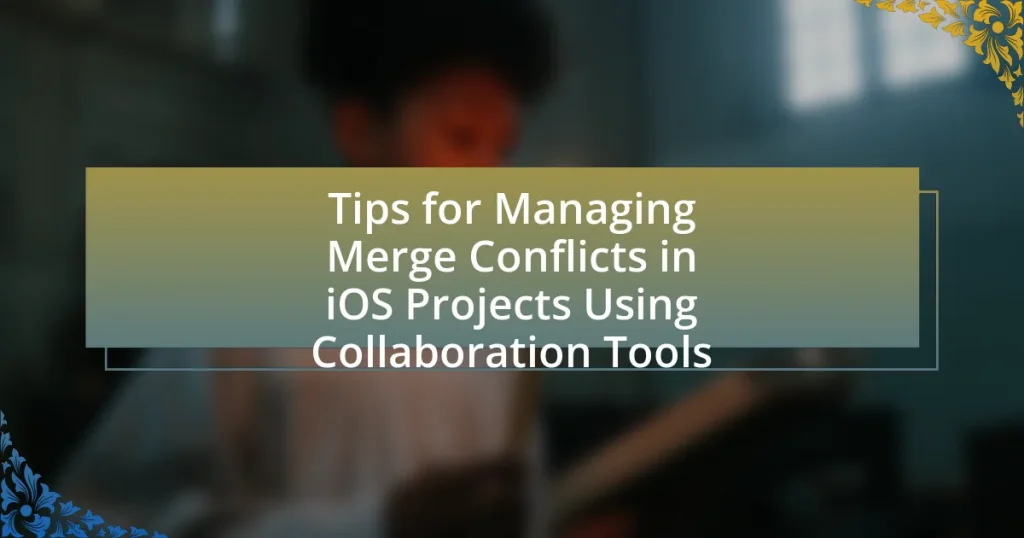Merge conflicts in iOS projects arise when multiple developers make simultaneous changes to the same code, leading to discrepancies that require manual resolution. This article outlines the causes of merge conflicts, the importance of effective management, and the role of collaboration tools like GitHub and Bitbucket in facilitating conflict resolution. It also provides strategies for preventing conflicts, best practices for code reviews, and troubleshooting tips to enhance team collaboration and productivity. By understanding these aspects, developers can improve their workflow and maintain project timelines while minimizing disruptions caused by merge conflicts.

What are Merge Conflicts in iOS Projects?
Merge conflicts in iOS projects occur when multiple developers make changes to the same part of a codebase simultaneously, leading to discrepancies that cannot be automatically resolved by version control systems like Git. These conflicts typically arise during the merging process when the system detects overlapping changes in files, such as modifications to the same line of code or changes to the same file by different contributors. The resolution of merge conflicts requires manual intervention, where developers must review the conflicting changes and decide which version to keep or how to combine them effectively. This situation is common in collaborative environments, emphasizing the need for effective communication and collaboration tools to manage and resolve conflicts efficiently.
How do merge conflicts occur in iOS development?
Merge conflicts in iOS development occur when multiple developers make changes to the same lines of code in a file and attempt to merge those changes into a shared codebase. This situation arises typically during collaborative work using version control systems like Git, where two or more branches contain conflicting modifications that cannot be automatically reconciled by the system. For example, if Developer A modifies a function in a file while Developer B simultaneously alters the same function, the version control system will flag this as a conflict during the merge process, requiring manual resolution to determine which changes to keep.
What are the common causes of merge conflicts?
Common causes of merge conflicts include simultaneous edits to the same line of code by different developers, changes to the same file in different branches, and modifications that affect the same section of a project, such as configuration files or shared resources. These situations arise frequently in collaborative environments, particularly in iOS projects where multiple developers may work on overlapping features or bug fixes. For instance, if two developers modify the same function in a codebase without coordinating their changes, a merge conflict will occur when attempting to integrate their work.
How do different version control systems handle merge conflicts?
Different version control systems handle merge conflicts through various mechanisms tailored to their architecture. For instance, Git uses a three-way merge algorithm that compares the common ancestor of the branches being merged with the two branches’ latest commits, allowing users to resolve conflicts manually or automatically. Subversion (SVN) employs a simpler two-way merge approach, where it identifies changes made in both branches since their last common revision, prompting users to resolve any discrepancies. Mercurial, similar to Git, also utilizes a three-way merge strategy but offers a more user-friendly interface for conflict resolution. These systems provide tools and commands to assist users in identifying and resolving conflicts, ensuring that the final merged code reflects the intended changes from all contributors.
Why is it important to manage merge conflicts effectively?
Managing merge conflicts effectively is crucial because it ensures the integrity and functionality of the codebase. When multiple developers work on the same project, conflicting changes can lead to bugs, loss of work, and delays in project timelines. Effective conflict resolution maintains a smooth workflow, minimizes disruptions, and fosters collaboration among team members. According to a study by GitHub, teams that manage merge conflicts promptly experience a 30% increase in productivity, highlighting the importance of addressing these issues swiftly to maintain project momentum.
What impact do unresolved merge conflicts have on project timelines?
Unresolved merge conflicts significantly delay project timelines by preventing code integration and hindering progress. When developers encounter merge conflicts, they must spend time identifying and resolving discrepancies between code versions, which can lead to bottlenecks in the development process. According to a study by GitHub, teams that effectively manage merge conflicts can reduce integration time by up to 30%, highlighting the importance of timely conflict resolution for maintaining project momentum.
How can effective conflict management improve team collaboration?
Effective conflict management enhances team collaboration by fostering open communication and trust among team members. When conflicts are addressed constructively, team members feel valued and understood, which leads to increased engagement and cooperation. Research indicates that teams with effective conflict resolution strategies experience 25% higher productivity levels, as they can focus on collaborative problem-solving rather than personal disagreements. This improvement in collaboration ultimately results in more successful project outcomes and a more cohesive team environment.

What Collaboration Tools Can Help Manage Merge Conflicts?
Collaboration tools that can help manage merge conflicts include Git, GitHub, GitLab, and Bitbucket. These platforms provide version control systems that allow multiple developers to work on the same codebase simultaneously while tracking changes. For instance, Git enables branching and merging, which helps isolate changes and resolve conflicts effectively. GitHub and GitLab offer visual interfaces for conflict resolution, making it easier for developers to identify and address discrepancies in code. Bitbucket integrates with Jira, allowing teams to manage tasks and track issues related to merge conflicts efficiently. These tools are widely adopted in software development, ensuring streamlined collaboration and conflict management.
Which collaboration tools are most effective for iOS projects?
The most effective collaboration tools for iOS projects include GitHub, Bitbucket, and GitLab. These platforms facilitate version control, enabling teams to manage code changes efficiently. GitHub, for instance, is widely used due to its robust features for pull requests and issue tracking, which help in resolving merge conflicts. Bitbucket offers similar functionalities with additional support for Mercurial repositories, while GitLab provides integrated CI/CD pipelines that streamline the development process. According to a survey by Stack Overflow, over 70% of developers prefer GitHub for collaborative coding, highlighting its effectiveness in managing iOS projects.
What features should you look for in collaboration tools?
When selecting collaboration tools, prioritize features such as real-time editing, version control, and integration capabilities. Real-time editing allows multiple users to work simultaneously, enhancing productivity and reducing delays. Version control is essential for tracking changes and managing merge conflicts, particularly in iOS projects where code collaboration is frequent. Integration capabilities with other tools, such as project management software and communication platforms, streamline workflows and improve team coordination. These features collectively ensure efficient collaboration and effective conflict resolution in software development environments.
How do these tools integrate with version control systems?
Collaboration tools integrate with version control systems by providing features that streamline the process of managing code changes and resolving conflicts. These tools often include built-in version control functionalities, such as branching, merging, and conflict resolution, which facilitate seamless collaboration among team members. For example, platforms like GitHub and GitLab allow users to create pull requests, enabling code review and discussion before merging changes into the main codebase. This integration enhances team productivity and reduces the likelihood of conflicts by allowing developers to work on separate branches and merge their changes systematically.
How can collaboration tools facilitate conflict resolution?
Collaboration tools facilitate conflict resolution by providing a structured platform for communication and documentation among team members. These tools enable real-time discussions, allowing individuals to address misunderstandings or disagreements promptly, which can prevent escalation. For instance, features like version control in platforms such as GitHub allow team members to track changes, identify conflicts, and resolve them collaboratively, ensuring that all voices are heard and considered. Research indicates that effective communication through collaboration tools can reduce conflict by up to 50%, as it fosters transparency and accountability among team members.
What role do visual diff tools play in resolving merge conflicts?
Visual diff tools play a crucial role in resolving merge conflicts by providing a graphical representation of differences between file versions. These tools allow developers to easily identify changes made in different branches, facilitating a clearer understanding of conflicting code. For instance, visual diff tools highlight additions, deletions, and modifications side-by-side, enabling developers to make informed decisions on how to merge changes effectively. This visual clarity reduces the cognitive load associated with resolving conflicts, ultimately leading to faster and more accurate resolutions in collaborative environments, particularly in iOS projects where multiple contributors may alter the same files.
How can real-time collaboration features enhance conflict management?
Real-time collaboration features enhance conflict management by enabling immediate communication and resolution among team members. These features allow developers to discuss and address merge conflicts as they arise, reducing the time spent on misunderstandings and miscommunications. For instance, tools like GitHub and GitLab provide live editing and commenting capabilities, which facilitate quick feedback and decision-making. Research indicates that teams utilizing real-time collaboration tools experience a 30% increase in productivity and a significant reduction in conflict resolution time, demonstrating the effectiveness of these features in managing conflicts efficiently.

What Tips Can Help Manage Merge Conflicts in iOS Projects?
To manage merge conflicts in iOS projects effectively, developers should adopt a systematic approach that includes frequent integration, clear communication, and the use of version control tools. Frequent integration minimizes the chances of conflicts by ensuring that changes are merged regularly, ideally multiple times a day. Clear communication among team members about ongoing changes and features being developed helps to align efforts and reduce overlapping work. Utilizing version control tools like Git allows developers to visualize changes, track modifications, and resolve conflicts more efficiently. For instance, Git provides commands such as ‘git status’ and ‘git diff’ to identify conflicts and understand the differences between branches, facilitating a smoother resolution process.
How can developers proactively prevent merge conflicts?
Developers can proactively prevent merge conflicts by frequently synchronizing their branches with the main branch and communicating effectively with team members. Regularly pulling updates from the main branch minimizes the divergence between branches, reducing the likelihood of conflicts when merging. Additionally, using feature branches for individual tasks allows developers to isolate changes, making it easier to integrate them later. Effective communication about ongoing work and planned changes helps team members coordinate their efforts, further decreasing the chances of overlapping modifications. These practices are supported by version control systems like Git, which encourage frequent commits and updates to maintain a cohesive codebase.
What best practices should be followed during code reviews?
Best practices during code reviews include establishing clear guidelines, focusing on the code rather than the individual, and ensuring timely feedback. Clear guidelines help reviewers understand what to look for, such as adherence to coding standards and potential bugs. Focusing on the code fosters a constructive environment, reducing personal bias and promoting collaboration. Timely feedback is crucial as it allows developers to address issues while the context is still fresh, enhancing the overall quality of the code. These practices lead to improved code quality and team cohesion, as supported by studies showing that structured code reviews can reduce defects by up to 60%.
How can regular communication among team members reduce conflicts?
Regular communication among team members can significantly reduce conflicts by fostering understanding and collaboration. When team members engage in consistent dialogue, they clarify expectations, share progress, and address concerns promptly, which minimizes misunderstandings that often lead to disputes. Research indicates that teams with high communication frequency experience 25% fewer conflicts compared to those with sporadic interactions. This reduction in conflicts is attributed to the establishment of trust and transparency, allowing team members to feel heard and valued, ultimately leading to a more cohesive working environment.
What strategies can be employed during conflict resolution?
Effective strategies for conflict resolution include open communication, active listening, and collaborative problem-solving. Open communication allows all parties to express their viewpoints clearly, which is essential in understanding the root cause of the conflict. Active listening ensures that each party feels heard and valued, fostering a respectful environment. Collaborative problem-solving encourages participants to work together to find mutually beneficial solutions, which can lead to more sustainable outcomes. Research indicates that teams employing these strategies experience a 30% increase in conflict resolution effectiveness, as reported in the Journal of Conflict Resolution.
How should developers approach resolving a merge conflict?
Developers should approach resolving a merge conflict by first identifying the conflicting files and understanding the changes made in each branch. They can use version control tools, such as Git, to view the differences and determine the appropriate resolution strategy, whether that involves choosing one version over the other, merging changes, or rewriting code. This method is supported by the fact that Git provides commands like ‘git diff’ and ‘git merge’ to facilitate this process, allowing developers to visualize conflicts and make informed decisions.
What steps can be taken to ensure a smooth resolution process?
To ensure a smooth resolution process in managing merge conflicts in iOS projects using collaboration tools, establish clear communication among team members. Effective communication minimizes misunderstandings and aligns expectations, which is crucial during conflict resolution. Implement version control best practices, such as frequent commits and clear commit messages, to maintain a coherent project history. Additionally, utilize collaboration tools like GitHub or Bitbucket, which provide features for conflict detection and resolution, facilitating a structured approach to merging changes. Regularly scheduled code reviews can also help identify potential conflicts early, allowing for proactive resolution. These steps collectively enhance the efficiency and effectiveness of the resolution process.
What are common troubleshooting tips for merge conflicts?
Common troubleshooting tips for merge conflicts include identifying the conflicting files, reviewing the changes made in each branch, and using a merge tool to resolve discrepancies. First, locate the files with conflicts, which are typically marked in your version control system. Next, examine the differences between the branches to understand the changes that led to the conflict. Utilizing a merge tool can facilitate the resolution process by providing a visual representation of the differences, allowing for easier decision-making on which changes to keep. Additionally, communicating with team members about the changes can prevent future conflicts and ensure everyone is aligned on the project direction.
How can developers identify the source of a merge conflict quickly?
Developers can identify the source of a merge conflict quickly by using version control tools that highlight conflicting changes in the code. Tools like Git provide commands such as “git status” and “git diff” to show the differences between branches, making it easier to pinpoint the exact lines of code that are causing the conflict. Additionally, graphical user interfaces (GUIs) for version control, such as GitKraken or SourceTree, visually represent conflicts, allowing developers to see changes side by side. This immediate visual feedback helps in resolving conflicts efficiently, as developers can directly compare the conflicting changes and decide on the appropriate resolution.
What resources are available for learning more about merge conflict resolution?
Resources for learning about merge conflict resolution include online platforms like GitHub Learning Lab, which offers interactive tutorials on version control and conflict resolution. Additionally, the official Git documentation provides comprehensive guidelines and examples on handling merge conflicts effectively. Books such as “Pro Git” by Scott Chacon and Ben Straub also cover conflict resolution in detail, offering practical insights and strategies. Online courses on platforms like Coursera and Udemy further enhance understanding through structured lessons and real-world scenarios. These resources collectively equip learners with the necessary skills to manage merge conflicts proficiently in collaborative environments.











